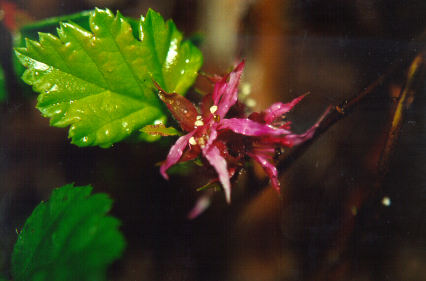Rubus nivalis
Rubus vestitus
snow dwarf bramble, snow dewberry
European blackberry
Leaf blades 3-6 cm. long, bright green and shining, glabrous, mostly simple, cordate-ovate, to 3-lobed, the margins dentate-serrate;
petioles with curved prickles.
Leaves alternate, partially evergreen, 3- to 5-foliate;
stipules lanceolate, 5-10 mm. long;
leaflets ovate to rotund-ovate, acuminate, 5-10 cm. long, doubly serrate, green and glabrous above, paler and pubescent beneath.
Flowers single or in pairs in the leaf axils;
calyx lobes 5, ovate-lanceolate, pointed, 6-9 mm. long, reflexed, usually purplish;
petals inconspicuous, pink to dull purple, narrowly elliptic, somewhat longer than the sepals;
stamens about 15, filaments slender, purplish;
pistils 4-9, pubescent.
Flowers numerous in flat-topped panicles, hairy and stipitate-glandular;
calyx white-woolly, the 5 lobes reflexed, lanceolate, acuminate, up to 1 cm. long;
petals 5, white, pinkish tinged, 10-15 mm. long;
stamens at least 75;
pistils numerous, styles glabrous.
Drupelets large, red;
seeds 3-4 mm. long, wrinkled.
Drupelets coherent, and with the receptacle forming a globular blackberry about 1.5 cm. thick.
Rubus nivalis
Rubus vestitus
- Local floras:
BC,
CA,
OR,
WA
- Local Web sites:
CalFlora,
CalPhotos,
Flora NW,
PNW Herbaria
WildflowerSearch
iNaturalist (observations)
USDA Plants Database
- LBJ Wildflower Center
- SEINet
- Plants of the World Online
- Encyclopedia of Life
- Wikipedia
- Google Image Search
- Local floras:
BC,
OR,
WA
- Local Web sites:
Flora NW,
PNW Herbaria
WildflowerSearch
iNaturalist (observations)
USDA Plants Database
- LBJ Wildflower Center
- SEINet
- Plants of the World Online
- Encyclopedia of Life
- Wikipedia
- Google Image Search



